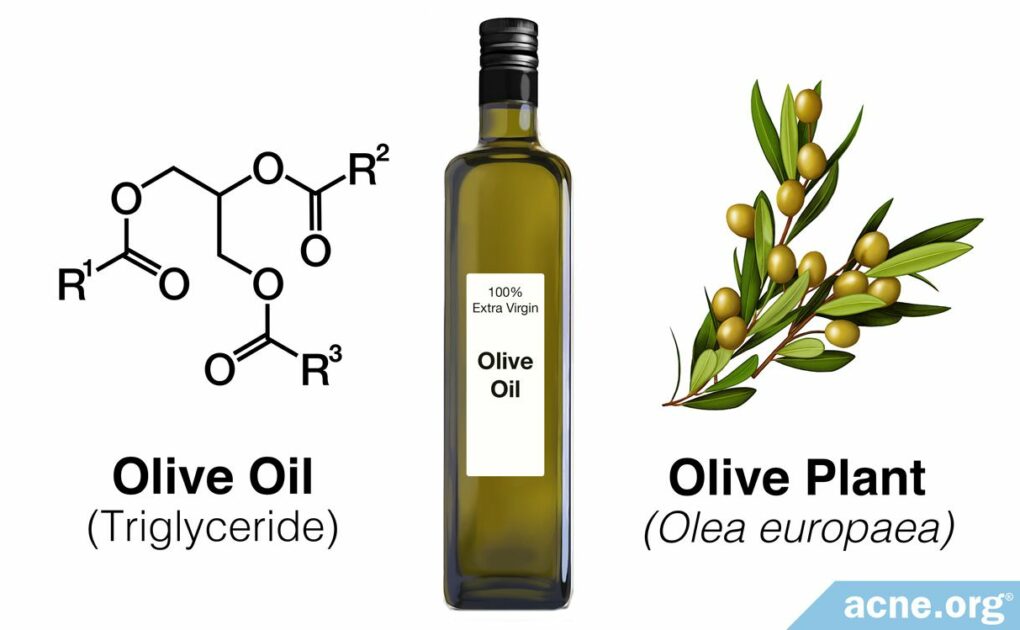Olive Oil May Be Beneficial for Overall Healthy Skin, but May Not Be Safe for Acne-prone Skin

The Essential Info
4 Positives: Topical olive oil can:
- Delay bacterial growth
- Promote wound healing
- Provide antioxidants to the skin
- Increase topical medication absorption
These 4 properties make olive oil a potentially beneficial oil for overall skin health.
1 Unknown: It is important for people with acne to maintain a strong skin barrier. Studies show us conflicting results regarding how olive oil affects the skin barrier, with 2 studies showing us it may negatively affect the skin barrier and 2 studies showing it may positively affect the skin barrier.
1 Big Negative: Research has found that olive oil may be slightly comedogenic, meaning that it may clog pores to some degree.
The Bottom Line: While olive oil may be beneficial for the skin overall, it may be ill-suited for people with acne-prone skin. Other non-comedogenic oils, like sunflower oil, safflower oil, and jojoba oil are better choices for people with acne because they are beneficial for skin health and do not clog pores.

The Science
- How Olive Oil Acts on the Skin
- Skin Barrier
- Antibacterial Properties
- Wound Healing
- Antioxidants
- Increase in Skin Absorption
People have used oils, including olive oil, on the skin for centuries because some oils can help to improve:
- Skin hydration – some oils can help keep moisture inside the skin
- General skin condition – oils can provide a protective barrier on the skin
Oils are made up of molecules called fatty acids, which can have both beneficial properties as well as downsides. Each oil contains its own unique types and amounts of fatty acids, which provide the oil with different properties.
Olive oil is composed of three main fatty acids:
- Oleic acid (72.8%)
- Palmitic acid (11.5%)
- Linoleic acid (10.8%)
It also contains vitamins A, D, E, K, and other antioxidants. Antioxidants are important for the skin because they help to counteract the effect of toxic molecules that can harm the skin.
Scientists have found that both topical application and oral consumption of olive oil has the following effects on the skin:
- Anti-inflammatory – this is potentially interesting because acne is an inflammatory disease
- Anti-aging
- Anti-carcinogenic
One big negative: However, on the downside, the fatty acid mixture found in some oils make the oil comedogenic (clogs pores).1-2 When tested on rabbit ears, olive oil scored a 2 out of 5 for pore clogging, which is considered only mildly comedogenic, but comedogenic nonetheless.3-5
Other oils, like sunflower oil, safflower oil, and jojoba oil, are non-comedogenic (do not clog pores), and are better options for people with acne.
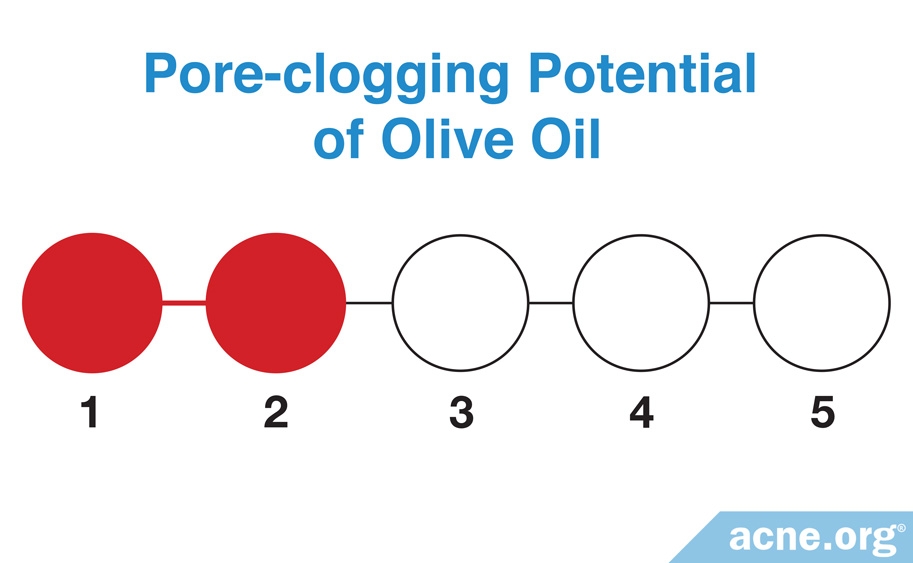
How Olive Oil Acts on the Skin
Olive oil acts on the skin through 5 distinct mechanisms. These include:
- Affecting the skin barrier
- Possessing antibacterial properties
- Supporting wound healing
- Providing antioxidants
- Increasing permeability of the skin
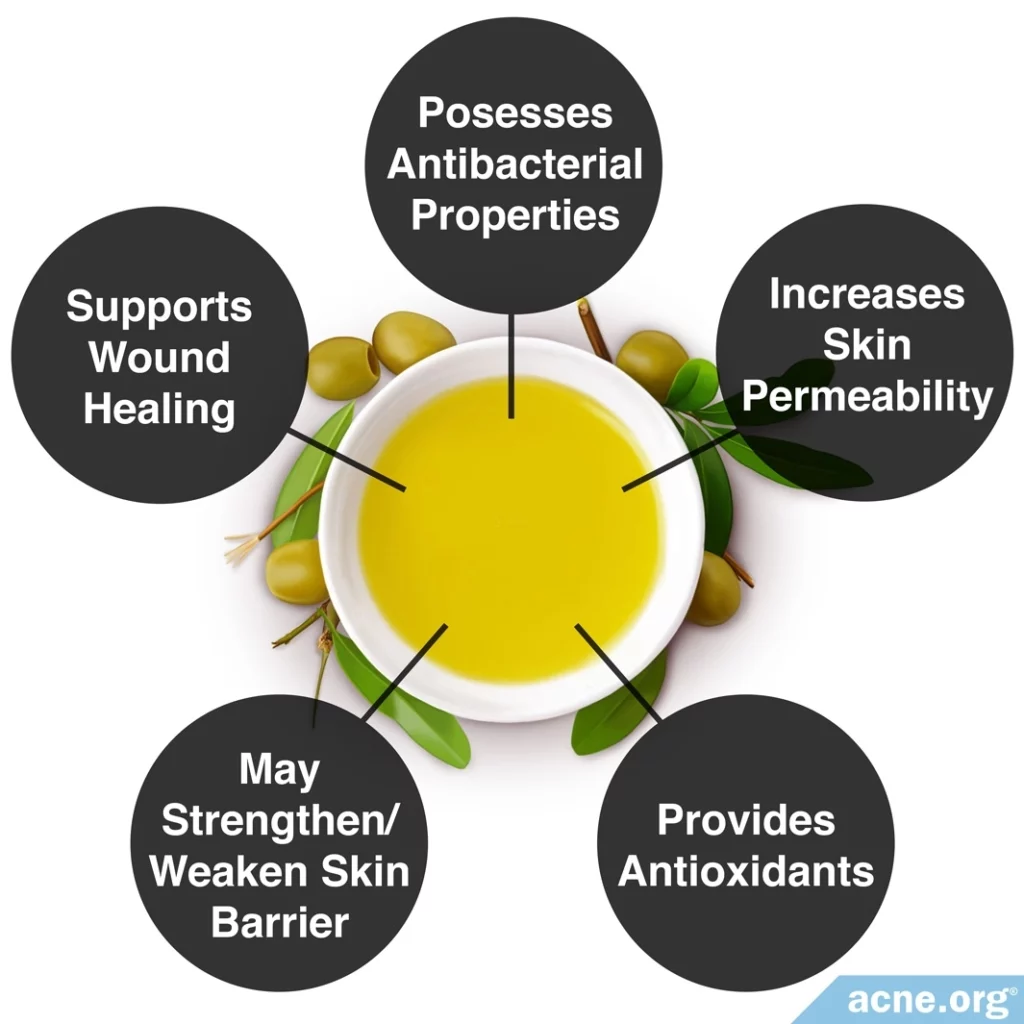
Let’s have a closer look at these mechanisms now, one by one.
Olive Oil and the Skin Barrier
A strong skin barrier is crucial for healthy skin. The skin barrier:
- Maintains skin hydration
- Prevents harmful substances from entering into the body
People with acne may have an impaired skin barrier function, so when it comes to acne, it is imperative that we keep the skin barrier intact and healthy.
Scientists investigating the effect of olive oil on the skin barrier have reported conflicting conclusions:
- 2 studies found that olive oil may decrease barrier function.6,7
- 3 other studies have found that olive oil may increase barrier function.3,8,9
However, none of these studies were perfect, so more high-quality studies are needed to settle the question of whether olive oil is beneficial or harmful for the skin barrier.
Expand to read details of studies on olive oil and decreased skin barrier function

A 2002 study published in the journal of Acta Paediatrica examined the effect of vegetable oils on the skin barrier function in mice. To perform this study, the researchers gently damaged the skin of mice and then topically applied various oils to examine how well each oil repaired the skin’s barrier function. They found that olive oil delayed recovery of the barrier function, while oils like sunflower oil increased the barrier function. Therefore, the scientists concluded that using olive oil on the skin should be avoided.6

A 2013 study published in the journal of Pediatric Dermatology examined the effect of olive oil and sunflower oil on the skin barrier in adults with a skin disease called atopic dermatitis. Atopic dermatitis causes skin rashes, dryness, bumps, redness, and itching. To perform this study, the researchers had 19 volunteers with and without atopic dermatitis apply olive oil and sunflower oil twice daily to each forearm for five weeks. The researchers found that olive oil caused a dramatic decrease in the integrity of the skin barrier and caused itchiness, while sunflower oil was beneficial for the skin barrier. Therefore, the scientists concluded that treatment of the skin with olive oil should be avoided.7
Expand to read details of studies on olive oil and increased skin barrier function

A 2008 study published in the journal of Pediatric Dermatology examined the effect of oil creams on premature infants. The researchers divided 173 premature infants into 3 groups. Each group of infants received a cream containing either olive oil, a mixture of water and oil, or a control without oil. This cream was then applied topically to the newborn’s skin daily for 4 weeks. The study found that premature infants treated with the olive oil cream had less skin irritation and improved skin hydration compared to infants that received either of the other 2 creams. Therefore, the scientists concluded that the olive oil cream improved the skin barrier.8

A 2016 study published in the journal of Acta Dermato-Venereologica examined the effect of olive oil and sunflower oil on the skin hydration in newborn babies. The researchers divided 115 newborn babies into 3 groups. Each group of babies had olive oil, sunflower oil, or no oil applied topically to the skin twice daily for 4 weeks. The study found that both oil groups significantly improved skin hydration in newborn babies.3

A 2020 study published in the Journal of Pharmacopuncture tested the ability of a combination of olive oil and aloe vera to improve skin barrier function in people with atopic dermatitis. Atopic dermatitis is an inflammatory condition involving dry and itchy skin, and scientists believe that a damaged skin barrier may be one of the key causes of this condition. The researchers divided 36 patients with atopic dermatitis 2 groups. The first group applied a cream containing olive oil and aloe vera to the skin for 6 weeks. The second group applied topical betamethasone, a steroid cream that is commonly used to treat atopic dermatitis, to the skin for 6 weeks. The patients who used the olive oil and aloe vera cream experienced 64.5% improvement in the severity of their symptoms, compared to 13.5% improvement for the patients who used betamethasone. It is likely that the improvement with the olive oil and aloe vera cream was due to improved skin barrier function.9 However, it is important to note that we do not know for sure whether it was the olive oil or the aloe vera, or perhaps both, that were responsible for this beneficial effect.
Olive Oil and Antibacterial Properties
Studies examining the antibacterial effect of olive oil, while not all in agreement, have generally found that olive oil may have some antibacterial properties. Acne is, in part, a bacterial disease, so this would suggest that olive oil might be at least somewhat helpful in this way.5,10,11
Expand to read details of studies on olive oil and antibacterial properties

A 2005 study published in Archives of Medical Research investigated the antibacterial effect of a mixture of olive oil, beeswax, and honey. To perform this study, the researchers grew two bacterial strains in a plate containing either agar or an agar and honey mixture. Agar is a gelatin-like substance often used to grow bacteria. Then they added varying concentrations of honey, olive oil, and beeswax onto the plate to determine which combination had the most effective antibacterial properties. The researchers found that honey had the strongest antibacterial properties and, if present at a high enough concentration, could entirely prevent bacterial growth. Olive oil also had antibacterial properties, which, although not as strong as honey, could delay growth of bacteria.10

A 2013 paper published in the African Journal of Traditional, Complementary, and Alternative Medicine reported on three studies investigating the antibacterial properties of olive oil. These three studies all found that olive oil had antibacterial properties against H. pylori bacteria isolated from human patients. While H. pylori is not the bacteria involved in acne, olive oil might have similar effects against C. acnes, the bacteria implicated in some of the inflammation characteristic in the latter stages of acne lesions. Attempting to repeat the results of this experiment, the authors of this article examined the antibacterial effects of an olive oil and lime cream. However, unlike the previous three studies, the authors of this article found that olive oil had no antibacterial properties. The reason for the conflicting results of these four experiments is unknown.5

A 2015 study published in the journal Physical Therapy studied the antibacterial effects of olive oil byproducts obtained from the leaves, stems, flower, fruit pulp, and seeds of the olive oil tree. The researchers first prepared extracts from the olive oil byproducts and tested them for a variety of properties. The researchers found that these byproducts have antibacterial, antioxidant, and anti-aging properties.11
On the other hand, lab studies also show that some components of olive oil may stimulate the growth of Malassezia, a type of fungus that can cause inflammation of the skin.12,13 In other words, while olive oil might halt the growth of bacteria that contribute to acne, it might simultaneously promote the growth of fungus, which can lead to other skin conditions.
For this reason, the authors of a 2012 article in the journal Archives of Pediatrics and Adolescent Medicine wrote:

“Based on the evidence currently available, it may be prudent to avoid organic oils, especially olive oil, when treating…inflammatory skin diseases.”13
Olive Oil and Wound Healing
Acne lesions are a type of wound, and inflammation is always present in and around acne lesions. Inflammation can delay wound healing, lead to scarring, and increase the chance that hyperpigmentation (red/dark marks) will be left on the skin after the lesion heals.
Studies have shown that olive oil can promote wound healing and reduce inflammation in both animals and humans. The studies below include research on both topical and oral olive oil. However, keep in mind when reading the studies that the effects of oral olive in the diet may not be the same when it comes to topical olive oil.14-18
Expand to read details of studies on olive oil and wound healing

A 2014 study published in the journal of Advances in Skin and Wound Care examined the healing effect of olive oil when administered topically on burn wounds in rats. The researchers treated a group of 60 rats with either olive oil or a mixture of olive oil and other oils daily for 28 days. The researchers found that olive oil by itself, as well as any oil mixture that contained olive oil, caused faster wound healing. Therefore, the researchers concluded that olive oil was beneficial in the treatment of burn wounds in rats.14

A 2014 study published in the journal of Wound Repair and Regeneration examined the effects of oral olive oil supplementation on wound healing in mice. To perform this study, the scientists wounded the skin of mice, and then provided the mice with oral olive or fish oil supplementation for 14 days. They concluded that olive oil, but not fish oil, improved wound healing by supporting skin cell and blood vessel growth in the mouse skin.15

A 2015 study published in the Journal of Wound Care examined the efficacy of aloe vera and olive oil combinations on treatment of 60 patients with chronic wounds. To perform this study, the researchers had the participants apply an aloe vera/olive oil cream or a control cream topically to their skin lesions twice daily for 30 days. The researchers found that the aloe vera/olive oil cream reduced wound size, depth, damaged tissue, swelling, and improved wound color. However, the study examined a cream containing a combination of aloe vera and olive oil, and therefore the researchers were unable to determine whether the olive oil by itself could induce the same level of wound healing as the combination of aloe and olive oil.16

A 2015 study published in the journal Burns examined the effect of oral olive oil supplementation on wound healing in human patients. To perform this study, the researchers gave hospitalized patients with second-degree burns oral olive oil supplements in their diet. The scientists concluded that the wounds of patients treated with olive oil supplementation healed faster and the patients had a decreased hospitalization stay compared to the control group. Therefore, the researchers concluded that oral supplementation of olive oil may “accelerate wound healing” in human burn patients.17

A 2016 study published in Journal of Dermatological Science examined the effect of olive oil on wound healing in mice. In this study, ulcers on the skin of mice were treated daily with topical application of olive oil or water. The researchers found that olive oil reduced inflammation and the production of inflammatory molecules in the mouse skin. Further, skin cell repair was accelerated in the olive oil treated mice. Therefore, the researchers concluded that olive oil improves wound healing and inflammation in mice.18

A 2023 study published in the journal Nutrients tested the ability of extra virgin olive oil to improve growth in human skin cells in a petri dish. The researchers found that adding substances found in olive oil to the petri dish stimulated the skin cells to grow. Since wound healing involves the growth of new skin cells, this suggests that topical olive oil might contribute to wound healing.19
Olive Oil and Antioxidants
Antioxidants are important molecules that counteract the effect of harmful chemicals found in the skin. Olive oil contains antioxidants, including vitamin E, which is the most abundant antioxidant naturally found in the skin.
Topical application of olive oil increases the levels of antioxidants in the skin and promotes the production of additional antioxidant compounds inside skin cells.20-22 Maintaining an adequate amount of antioxidants in the skin may be important for acne, so in this way, olive oil could potentially be beneficial.
Olive Oil and An Increase in Skin Absorption
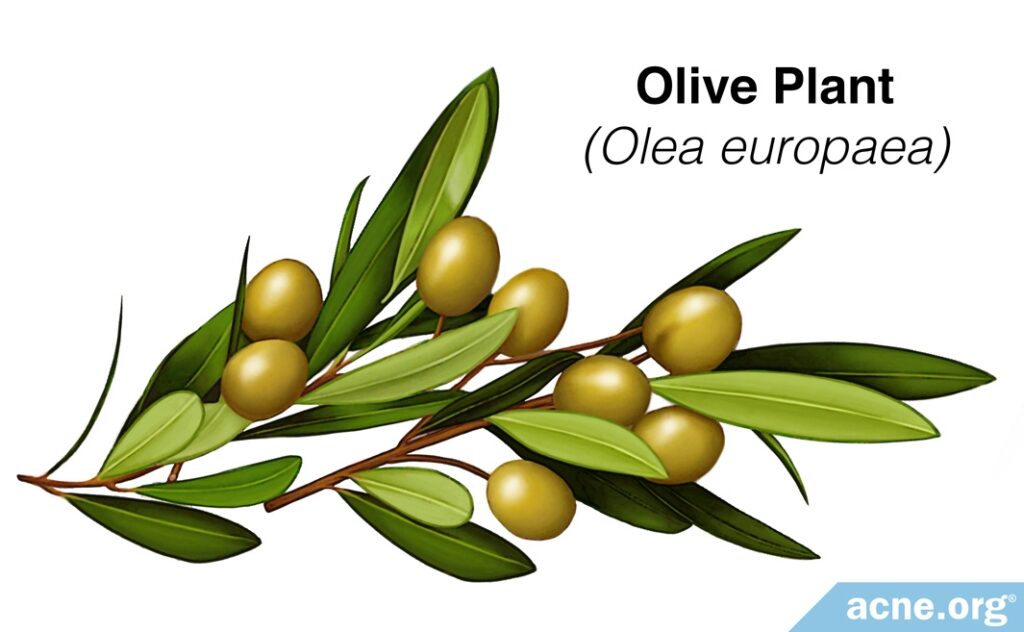
Oils are substances that can increase the absorption of medications or other molecules into the skin. Oils with a large amount of oleic acid are the best at increasing skin absorption. Olive oil is composed of nearly 80% oleic acid, so olive oil can increase the absorption of drugs or other molecules into the skin.23 This would be a potentially beneficial quality for increasing absorption of acne medication.
Overall, olive oil may be beneficial for skin health. However, due to its mildly comedogenic properties, it is not recommended for acne-prone skin. Other oils, such as sunflower oil, safflower oil, and jojoba oil may be better options for acne sufferers, since they are beneficial to the skin and also non-comedogenic.
References
- Parente, M. E., Gámbaro, A., Boinbaser, L. & Roascio, A. Sensory characterization of virgin olive oil-based cosmetic creams. J. Cosmet. Sci. 64, 371 – 380 (2013). https://www.ncbi.nlm.nih.gov/pubmed/24139435
- Fulton, J. E. Comedogenicity and irritancy of commonly used ingredients in skin care products. J. Soc. Cosmet. Chem. 40, 321 – 333 (1989). http://www.nononsensecosmethic.org/wp-content/uploads/2013/12/Comedogenicity-and-irritacy-of-commonly-used-ingredients.pdf
- Cooke, A. et al. Olive oil, sunflower oil or no oil for baby dry skin or massage: A pilot, assessor-blinded, randomized controlled trial (the Oil in Baby SkincaRE [OBSeRvE] Study). Acta Derm. Venereol. 96, 323 – 331 (2016). https://www.ncbi.nlm.nih.gov/pubmed/26551528
- Viola, P. & Viola, M. Virgin olive oil as a fundamental nutritional component and skin protector. Clin. Dermatol. 27, 159 – 165 (2009). https://www.ncbi.nlm.nih.gov/pubmed/19167997
- Sumer, Z., Yildirim, G., Sumer, H. & Yildirim, S. Cytotoxic and antibacterial activity of the mixture of olive oil and lime cream in vitro conditions. African J. Tradit. Complement. Altern. Med. 10, 137 – 143 (2013). https://www.ncbi.nlm.nih.gov/pmc/articles/PMC3794404/
- Darmstadt, G. L. et al. Impact of topical oils on the skin barrier: possible implications for neonatal health in developing countries. Acta Paediatr. 91, 546 – 554 (2002). https://www.ncbi.nlm.nih.gov/pubmed/12113324
- Danby, S. G. et al. Effect of olive and sunflower seed oil on the adult skin barrier: Implications for neonatal skin care. Pediatr. Dermatol. 30, 42 – 50 (2013). https://www.ncbi.nlm.nih.gov/pubmed/22995032
- Kiechl-Kohlendorfer, U., Berger, C. & Inzinger, R. The effect of daily treatment with an olive oil/lanolin emollient on skin integrity in preterm infants: A randomized controlled trial. Pediatr. Dermatol. 25, 174 – 178 (2008). https://onlinelibrary.wiley.com/doi/abs/10.1111/j.1525-1470.2008.00627.x
- Panahi, Y., Rastgar, N., Zamani, A. & Sahebkar, A. Comparing the therapeutic effects of Aloe vera and olive oil combination cream versus topical betamethasone for atopic dermatitis: A randomized double-blind clinical trial. J. Pharmacopuncture 23, 173-178 (2020). https://pubmed.ncbi.nlm.nih.gov/33072415/
- Al-Waili, N. S. Mixture of honey, beeswax and olive oil inhibits growth of Staphylococcus aureus and Candida albicans. Arch. Med. Res. 36, 10 – 13 (2005). https://www.ncbi.nlm.nih.gov/pubmed/15777988
- Kishikawa, A. et al. Multiple biological effects of olive oil by-products such as leaves, stems, flowers, olive milled waste, fruit pulp, and seeds of the olive plant on skin. Phyther. Res. 29, 877 – 886 (2015). https://www.ncbi.nlm.nih.gov/pubmed/25779104
- Karagounis, T. K., Gittler, J. K., Rotemberg, V. & Morel, K. D. Use of “natural” oils for moisturization: Review of olive, coconut, and sunflower seed oil. Pediatr. Dermatol. 36, 9 – 15. (2019). https://www.ncbi.nlm.nih.gov/pubmed/30152555
- Siegfried, E. & Glenn, E. Use of olive oil for the treatment of seborrheic dermatitis in children. Arch. Pediatr. Adolesc. Med. 166, 967 (2012). https://www.ncbi.nlm.nih.gov/pubmed/22893193
- Edraki, M., Akbarzadeh, A., Hosseinzadeh, M. & Tanideh, N. Healing effect of sea buckthorn, olive oil, and their mixture on full-thickness burn wounds. Adv. Skin Wound Care 27, 317 – 323 (2014). https://www.ncbi.nlm.nih.gov/pubmed/24932952
- Rosa, A. D. S., Bandeira, L. G., Monte-Alto-Costa, A. & Romana-Souza, B. Supplementation with olive oil, but not fish oil, improves cutaneous wound healing in stressed mice. Wound Repair Regen. 22, 537 – 547 (2014). https://www.ncbi.nlm.nih.gov/pubmed/25041622
- Panahi, Y. et al. Comparative trial of Aloe vera/ olive oil combination cream versus phenytoin cream in the treatment of chronic wounds. J. Wound Care 24>, 459 – 465 (2015).
- Najmi, M., Shariatpanahi, Z. V., Tolouei, M. & Amiri, Z. Effect of oral olive oil on healing of 10-20% total body surface area burn wounds in hospitalized patients. Burns 41, 493 – 496 (2015). https://www.ncbi.nlm.nih.gov/pubmed/25306088
- Donato-Trancoso, A., Monte-Alto-Costa, A. & Romana-Souza, B. Olive oil-induced reduction of oxidative damage and inflammation promotes wound healing of pressure ulcers in mice. J. Dermatol. Sci. 83, 60 – 69 (2016). https://www.ncbi.nlm.nih.gov/pubmed/27091748
- González-Acedo, A., Ramos-Torrecillas, J., Illescas-Montes, R., Costela-Ruiz, V. J., Ruiz, C., Melguizo-Rodríguez, L. & García-Martínez, O. The benefits of olive oil for skin health: Study on the effect of hydroxytyrosol, tyrosol, and oleocanthal on human fibroblasts. Nutrients 15, 2077 (2023). https://pubmed.ncbi.nlm.nih.gov/37432217/
- Bowe, W. P. & Pugliese, S. Cosmetic benefits of natural ingredients. J. Drugs Dermatol. 13, 1021 – 1025 (2014). https://www.ncbi.nlm.nih.gov/pubmed/25226001
- Gorzynik-Debicka, M., Przychodzen, P., Cappello, F. et al. Potential health benefits of olive oil and plant polyphenols. Int. J. Mol. Sci. 19, 686 (2018). https://www.ncbi.nlm.nih.gov/pmc/articles/PMC5877547/
- Jeon, S. & Choi, M. Anti-inflammatory and anti-aging effects of hydroxytyrosol on human dermal fibroblasts (HDFs). Biomed. Dermatol. 2, 21 (2018). https://biomeddermatol.biomedcentral.com/articles/10.1186/s41702-018-0031-x#citeas
- Viljoen, J. M., Cowley, A., du Preez, J., Gerber, M. & du Plessis, J. Penetration enhancing effects of selected natural oils utilized in topical dosage forms. Drug Dev. Ind. Pharm. 41, 2045 – 2054 (2015). https://www.ncbi.nlm.nih.gov/pubmed/26161938
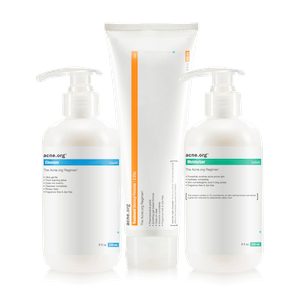 Acne.org Products
Acne.org Products